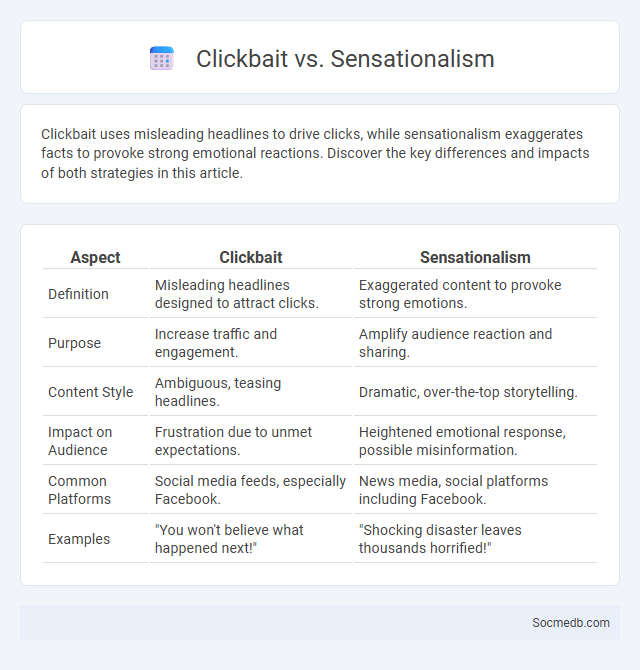
Photo illustration: Clickbait vs sensationalism
Clickbait uses misleading headlines to drive clicks, while sensationalism exaggerates facts to provoke strong emotional reactions. Discover the key differences and impacts of both strategies in this article.
Table of Comparison
| Aspect | Clickbait | Sensationalism |
|---|---|---|
| Definition | Misleading headlines designed to attract clicks. | Exaggerated content to provoke strong emotions. |
| Purpose | Increase traffic and engagement. | Amplify audience reaction and sharing. |
| Content Style | Ambiguous, teasing headlines. | Dramatic, over-the-top storytelling. |
| Impact on Audience | Frustration due to unmet expectations. | Heightened emotional response, possible misinformation. |
| Common Platforms | Social media feeds, especially Facebook. | News media, social platforms including Facebook. |
| Examples | "You won't believe what happened next!" | "Shocking disaster leaves thousands horrified!" |
Understanding Clickbait: Definition and Characteristics
Clickbait refers to sensationalized or misleading headlines and thumbnails designed to attract clicks and drive traffic to online content. Key characteristics include exaggerated claims, curiosity gaps, and emotionally charged language that compel users to engage without offering immediate or clear information. Understanding these tactics is essential for improving digital literacy and recognizing content that prioritizes clicks over quality or accuracy.
What is Sensationalism? Key Elements Explained
Sensationalism in social media involves exaggerating or distorting information to provoke strong emotional reactions and increase engagement. Key elements include emotionally charged headlines, misleading or clickbait content, and selective emphasis on dramatic aspects rather than balanced facts. Your ability to critically evaluate these tactics helps avoid misinformation and promotes informed decision-making.
Clickbait vs Sensationalism: Core Differences
Clickbait uses exaggerated headlines to lure You into clicking content, often promising more than it delivers, while sensationalism amplifies emotions and controversial topics to provoke strong reactions. Clickbait typically prioritizes quantity of clicks, whereas sensationalism focuses on emotional impact and audience engagement. Understanding these core differences helps You critically evaluate information on social media platforms and avoid misleading content.
Historical Evolution: How Clickbait and Sensationalism Emerged
Social media has evolved from simple communication platforms to complex ecosystems where clickbait and sensationalism thrive by exploiting user engagement algorithms. These strategies emerged as content creators and brands sought to maximize views, shares, and ad revenue by crafting provocative headlines and emotionally charged content that capture Your attention rapidly. The rise of real-time information sharing and competition for online visibility intensified the use of exaggerated or misleading content, shaping the modern social media landscape focused heavily on virality.
Motivations Behind Clickbait and Sensationalism
Clickbait and sensationalism on social media exploit psychological triggers such as curiosity, fear, and emotional arousal to increase user engagement and viral sharing. These tactics leverage algorithmic prioritization of content with high interaction rates, driving platform revenue through ad impressions. Understanding these motivations reveals how sensational content manipulates cognitive biases and social dynamics to maximize reach and influence.
Psychological Impact on Readers
Social media platforms can significantly influence the psychological well-being of readers by affecting self-esteem, anxiety, and mood. Exposure to curated content often leads to social comparison, potentially triggering feelings of inadequacy and depression. Continuous engagement with social media also impacts attention span and increases susceptibility to stress and information overload.
Ethical Implications in Digital Journalism
Social media platforms have transformed digital journalism by enabling rapid information dissemination, but they also present ethical challenges such as the spread of misinformation and the erosion of source credibility. Journalists must navigate issues of privacy, consent, and the potential for bias amplification while maintaining transparency and accountability in their reporting. Your critical evaluation of social media content is essential to uphold ethical standards and ensure the integrity of digital news.
Case Studies: Notorious Examples of Each
Case studies of social media mishaps reveal critical insights into platform vulnerabilities and user behavior. Examples like the Facebook-Cambridge Analytica scandal highlight significant data privacy breaches, while Twitter's struggles with misinformation expose challenges in content moderation algorithms. Understanding these instances equips you with greater awareness of potential risks and the importance of digital literacy on social networks.
Combatting Misinformation: Best Practices for Content Creators
Social media content creators play a crucial role in combatting misinformation by priorit fact-checking and verifying sources before sharing information. You should implement clear content guidelines that promote transparency and encourage your audience to critically evaluate news before accepting it as true. Leveraging platform tools for reporting false content and collaborating with reputable fact-checking organizations enhances the integrity of your social media presence.
Future Trends in Online Media Tactics
Emerging AI-driven personalization will reshape your social media strategies by delivering hyper-targeted content based on real-time user behavior and preferences. Augmented reality (AR) and virtual reality (VR) integrations will create immersive brand experiences that capture audience attention more effectively than traditional posts. Short-form video content, fueled by platforms like TikTok and Instagram Reels, will continue dominating engagement metrics and require dynamic creative approaches for sustained impact.
 socmedb.com
socmedb.com